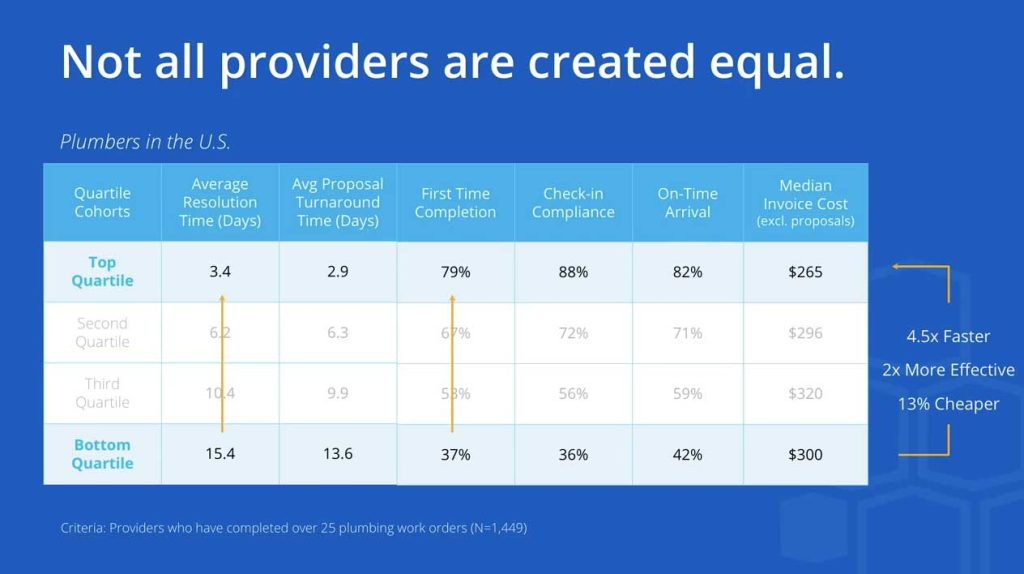Water Softener Maintenance Checklist: Cost-Saving Guide for Facility Managers

Dive into water softener maintenance and discover how setting up water softener checklists can help your water purification program succeed.
Staying on top of water softener maintenance protects your equipment, water quality, and budget. For multi-site operations, proper preventive maintenance reduces hard water damage, supports compliance, and prevents costly downtime.
A well-run checklist and facility management software make routine tasks easier to manage, more accurate to track, and harder to overlook.
This guide covers exactly what your team needs to inspect, clean, and monitor to keep your water-softening system running smoothly.
Developing a Preventive Maintenance Plan for Water Softeners
Breaking tasks into regular intervals makes tracking performance, catching problems early, and maintaining water quality across all locations easier.
Establish a Maintenance Schedule
Review the manufacturer’s instructions before building your maintenance schedule. Based on their design and components, models from Culligan, Kinetico, Whirlpool, and GE each have unique care requirements.
Organize checklists by time frame:
- Daily salt checks catch issues early.
- Weekly inspections spot wear before it builds.
- Monthly and quarterly cleanings keep systems efficient.
- Annual servicing tackles deeper mechanical issues.
Daily and Weekly Water Softener Maintenance
Start your day with a quick salt check. Top off the brine tank with rock salt or salt pellets to prevent hard water from entering your supply.
With a quick daily check, you’ll keep your system in top shape and avoid issues that can disrupt the entire water-softening process.
Daily checks should include:
- Confirm salt levels in the brine tank.
- Look for salt mushing or salt bridges.
- Test water hardness to confirm proper softening.
- Watch for error messages or unusual noises.
Weekly tasks:
- Inspect resin beads for discoloration (if your system allows).
- Verify that regeneration cycles are running as scheduled.
- Check water flow through the resin tank.
- Look for solid crusts of evaporated salt in the brine tank.
- Make sure you’re not using too much salt or adding new salt on top of old.
Monthly and Quarterly Maintenance
Clogs reduce efficiency and strain components like the resin bed and control valve. Once a month, give the brine tank a deep clean to remove old salt, sediment, and anything else that might block the regeneration cycle.
Check the brine float, too. If it’s stuck or buried in salt, it can’t regulate water levels properly and can throw off the softening process.
Stay on schedule to catch issues early and keep your water softener system running efficiently, even under heavy commercial loads.
Monthly tasks:
- Clean the brine tank to remove debris and mineral buildup.
- Inspect the brine float for sediment or blockage.
- Visually check the resin tank and surrounding parts for wear.
Quarterly tasks:
- Test water hardness at multiple points across your facility.
- Inspect the control valve and bypass valve for smooth operation.
- Clean the venturi valve to avoid suction issues during regeneration.
- Check the distribution arm to confirm even water flow.
- Verify system settings align with current water usage patterns.
Annual Water Softener Servicing
Your water softener works hard year-round. An annual inspection helps you catch rust, corrosion, or worn-out parts before they turn into costly repairs.
Inspecting every valve, seal, and circuit can feel endless when managing multiple locations, but a yearly checkup can prevent downtime and keep your system running smoothly. Asset management software helps you track part lifespans and forecast replacements before failures happen.
Annual checklist:
- Inspect the resin bed and clean or replace it if needed.
- Sanitize the system, especially in food service or healthcare settings.
- Check all electronic components and timers.
- Inspect seals, O-rings, and gaskets for wear or leaks.
- Calibrate and verify controller programming.
- Look for scale buildup or clogged lines.
Maintaining Records and Ensuring Compliance
Documenting maintenance routines helps verify system performance, supports regulatory audits, and prevents repeat issues. Accurate documentation is your best tool for keeping your water softening system consistent, safe, and on the right side of inspection requirements.
Managing spreadsheets and checklists across multiple sites can be challenging, but a centralized logging system significantly enhances efficiency. A facility management software system helps further by standardizing processes and keeping everything within reach.
Maintenance logs should include:
- Salt usage and settings changes.
- Water hardness test results.
- Regeneration cycle timing and outcomes.
- Notes from inspections, servicing, or component replacements.
Logs for Multi-Location Facilities
Tracking water softener maintenance across multiple sites is no small task. The right system makes compliance and coordination effortless, regardless of your nationwide operations. A centralized facility management system reduces missed steps and provides real-time visibility from anywhere.
Look for a solution that supports:
- Consistent procedures across all locations.
- Real-time updates from your maintenance staff.
- Automated alerts for missed or overdue tasks.
- Photo documentation for service verification.
- Built-in compliance reporting tools.
Aligning with NSF, EPA, and Water Quality Association Standards
Water safety is mission-critical if your facility prepares food, provides healthcare, or handles any consumable product. The NSF, EPA, and Water Quality Association standards keep facilities on task with water health and safety standards.
These organizations define what compliant water treatment looks like, and their guidelines ensure that your water passes strict regulatory expectations for production.
Precise and accurate compliance logs prevent fines, failed audits, and unexpected forced shutdowns. Accurate records show that you’re meeting standards and that your logs are accessible for inspections.
Water Softener Maintenance Budgeting & ROI
Justifying maintenance expenses to upper management isn’t easy, especially when everything seems to work just fine. However, water softener system maintenance prevents headaches while protecting your budget and equipment, from laundry to HVAC.
Building a case for preventive maintenance is easier when you’ve got the data to show the cost of doing nothing.
Let’s break it down.
Here’s a general idea of monthly costs for regular water softening system maintenance:
- Salt: $20–$50 per month, depending on hardness and usage. A cost calculator can estimate monthly salt costs for industrial and commercial water softeners based on your specific conditions.
- Labor: $100 to $250 per year, covering repairs, cleaning, salt refills, water testing, and annual inspections.
- Annual part replacement: $200–$400, based on age/model.
This is what skipping maintenance might cost:
- Emergency repair can range from $150–$600 per call.
- Replacing scaled equipment typically costs $700–$3,000+, depending on the model.
- Downtime or business disruption can mean thousands in lost revenue.
- Regulatory fines vary widely by jurisdiction.
Comparing Different Water Softener Systems
Time-Clock vs. Metered Regeneration Systems
The two most common water softener types are time-clock and metered regeneration systems. Each has its strengths, depending on your facility’s needs.
Time-clock systems regenerate on a fixed schedule, meaning more frequent water hardness testing and manual adjustments. These systems work well in locations with predictable, consistent daily usage.
Metered systems track actual water usage and only regenerate when needed, making them ideal for facilities with variable demand or off-peak usage cycles. They also tend to require less maintenance and use less salt over time. For multi-location facilities, metered systems usually offer better performance and lower upkeep.
Capacity & Size Considerations
Bigger isn’t always better. It’s just more to maintain. Larger systems with bigger brine tanks often need more frequent cleaning, and high-capacity softeners might require more frequent salt and resin replacements to keep up with heavy use.
Brands like Culligan and Kinetico offer commercial-grade options built for high-volume demand, while GE and Whirlpool models often cater to lighter usage needs.
Don’t size your system based on average use alone. Factor in peak demand periods, especially if your facility sees surges in water consumption. Regions where hardness levels often exceed 15 grains per gallon may require larger capacity systems or more frequent maintenance to stay ahead of buildup and keep heavy metals out of the water supply.
Special Ingredient Water Applications
When softened water is used for food prep, medical applications, or product manufacturing, stakes are higher, and regulations are stricter. These water-softening systems need a tighter maintenance schedule and a sharper eye for detail.
Keeping up takes a lot of effort, mainly when patients, guests, or customers rely on consistently safe, clean water. But staying on top of your system’s needs gives you peace of mind and helps ensure regulatory compliance. Food-safe water starts with proper maintenance, which begins with attention to the details most systems miss.
For ingredient applications, consider these added requirements:
- Sanitize quarterly with NSF-approved water softener cleaners.
- Test water weekly to verify system effectiveness.
- Use the correct salt pellets or rock salt based on your system and application needs.
- Inspect the brine grid to confirm even salt distribution and brine draw.
- Monitor water pressure to prevent system strain or inconsistent flow
- Align documentation with FDA, EPA, or other relevant standards
- Receive an annual inspection by a certified water treatment specialist.
Integrating Water Softener Maintenance Into Your Full Treatment Program
Water softener systems are one step in a larger filtration system, especially in facilities that rely on reverse osmosis (RO) or deionization (DI) for final polishing. If one step falls out of sync, it can throw the whole process off balance.
Coordinate maintenance across your entire integrated treatment system. When mineral particles like iron, calcium, and magnesium slip through, you risk scale buildup on RO membranes, rust stains on your equipment, and undesirable results from downstream processes.
Coordinating systems gives you the peace of mind of knowing your water will reach the purest form possible, free from heavy metals and mineral particles. Follow these steps to set your water purification program up for success:
- Align system maintenance with downstream RO and DI schedules.
- Regularly test water quality between each stage.
- Track how softener setting changes affect downstream performance and regeneration process efficiency.
- Review source water trends to adjust treatment plans as needed.
Coordination with RO & Deionization Systems
Coordination of maintenance across systems is vital for multi-stage water treatment. A misstep upstream can lead to scale buildup or inconsistent performance downstream.
Well-maintained water softeners are your first line of defense, protecting RO membranes, DI cartridges, and other components from mineral buildup that can shorten equipment life and degrade water quality.
The effort pays off with cleaner water, fewer breakdowns, and longer-lasting equipment. These best practices help keep a full treatment system running smoothly:
- Schedule quarterly system inspections to catch cross-system issues early.
- Test water quality at every stage to catch anomalies early.
- Document how water softener adjustments impact downstream RO and DI output.
- Perform regular maintenance across all connected systems.
Multi-Facility Scheduling & Documentation
Managing water softener maintenance across multiple locations is an entirely different kind of challenge. Without the right systems, tracking documentation can feel like a full-time job.
A coordinated approach and centralized platform, such as work order management software, simplify procedures, reduce missed tasks, and give you big-picture visibility across teams.
These practices for multi-site coordination deliver results:
- Standardize maintenance procedures and documentation across all locations.
- Set up regional teams trained on your specific water softening systems.
- Automate reminders and alerts for upcoming or overdue tasks.
- Conduct annual training refreshers to keep processes consistent.
- Use centralized reporting to surface trends and identify system-wide issues.
How ServiceChannel Simplifies Water Softener Maintenance
Water softening system maintenance doesn’t have to be complicated. The right tools simplify preventive maintenance and reduce guesswork and paperwork.
ServiceChannel’s facility management software is built to handle everything from routine water softener maintenance to compliance tracking across multiple sites — one centralized solution that works with your team, not against it.
With ServiceChannel, you can:
- Automate maintenance task assignments and scheduling.
- Track completion with time stamps and photo verification.
- Monitor salt levels and system usage across multiple facilities.
- Generate audit-ready compliance reports with just a few clicks.
- Analyze costs and trends to plan for future maintenance.
- Maintain accurate equipment lifecycle records for smarter ROI decisions.
Let ServiceChannel do the heavy lifting so your team can focus on what matters most. Explore our platform today for more information.



